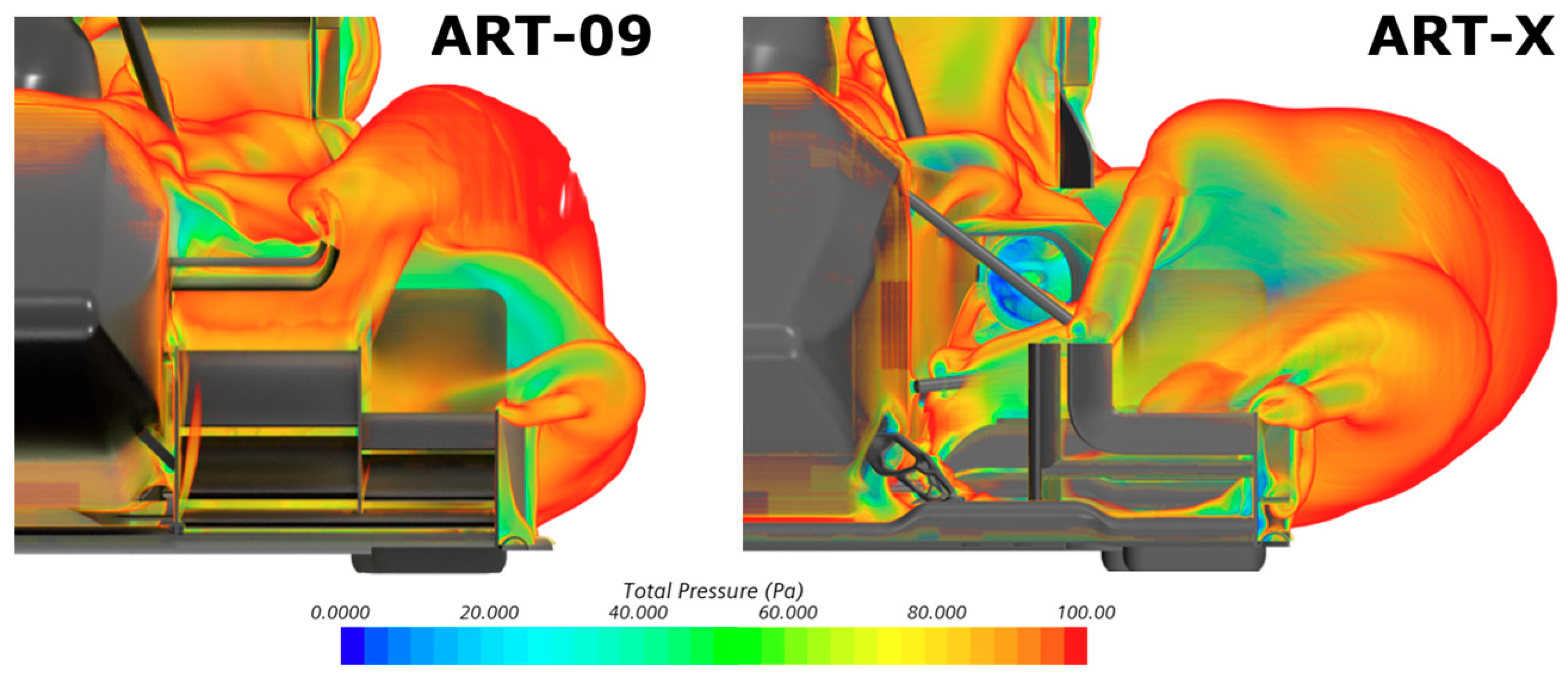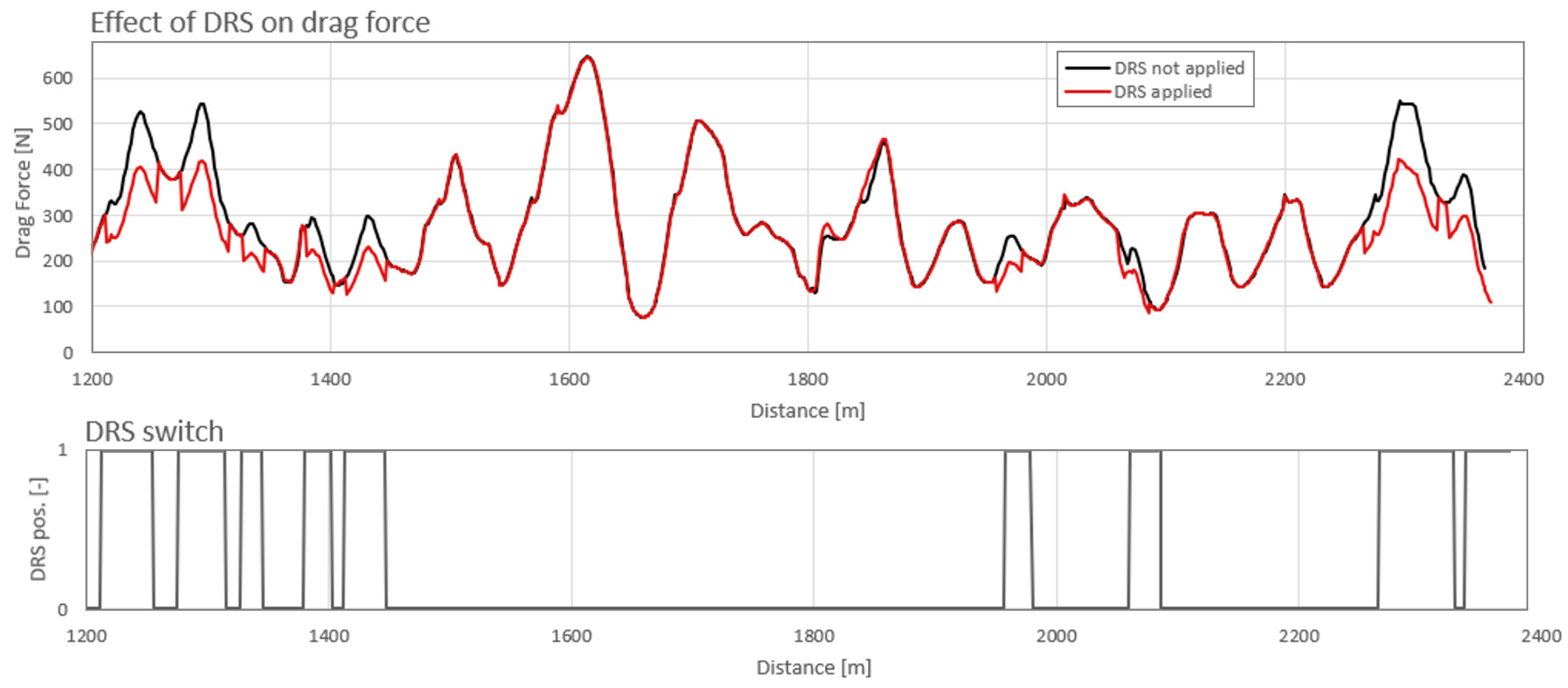1. Introduction
The Arrabona Racing Team (ART), which was established in 2014 at the Széchenyi István University of Győr, is continuously developing new Formula Student (FS) car models every year complying with the rules [
1] of the FS competition. This paper and its first part [
2] focus on the virtual modeling and design optimization of the ART_X model, which is the recent model by the ART.
Figure 1 shows the top view of an ART model.
In motorsport, each team has the same amount of time generally to design and test their prototype vehicles. It is critical to be able to analyze the performance virtually, and not by physical prototype, as that would be time- and resource-consuming. If the results are not as expected, enhancing the virtual prototype is a much faster and more effective process. This tendency has become valid not only in the fiercely competitive passenger vehicle industry, but also in motorsport.
Aerodynamics is crucial for road vehicles, especially race cars. Safety and agility can be guaranteed by high traction forces between the road and the tires. Traction is basically ensured by the friction force, which can be increased in general by increasing the normal force in the road–tire contact point. Therefore, the main goal of the aerodynamic package of race cars is to increase the downforce, which is basically a negative lift force. The challenge is that increased lift force generally goes hand-in-hand with increased drag force, which consumes the engine power. Depending on the vehicle, the racetrack, the weather and the asphalt conditions, the optimal balance of lift and drag coefficient must be found to minimize the lap time [
3,
4,
5,
6]. The lift and the drag forces
Flift and
Fdrag appear in the dynamic equations of the vehicle as
m ax =
Fdrive −
Fdrag and
m ay = −
m g +
Flift;
Flift < 0, where
m is the total mass of the vehicle and
a is its center of gravity acceleration. A new opportunity to avoid this serious tradeoff is to use the so-called drag reduction system (DRS). The fundamental idea is to reduce the aerodynamic drag coefficient at high speed in almost straight segments of the racetrack and increase the aerodynamic lift coefficient together with the drag force only on the slow segments of the track, where small radius cornering induces high lateral accelerations [
7,
8,
9,
10].
Besides a complete picture on race vehicle aerodynamic effects, the concept of multiple airfoil (or multi-element) wings is explained in [
6]. This idea is indispensable for the technical realization of such a concept of the DRS, where only the angle of a certain wing segment is modified. The numerical model was built, and the optimum opening angles were found using 3D computational fluid dynamics (CFD) simulations in [
7]. Reference [
8] focuses on DRS configuration optimization from an existent design of an FS car rear wing using 2D and 3D CFD simulations. The considered rear wing is a multi-element wing with three airfoils that produces a considerable fraction of the car’s total aerodynamic downforce. The optimal angles are investigated in different vehicle speeds. The drag and lift coefficient were analyzed in detail by means of 2D and 3D CFD simulations in [
9]. After collecting information on the 2D wing profile, a 3D model was created together with the electrical linear actuators and the end plates to evaluate the wing operation. The presence of the linear actuators somewhat spoiled the aerodynamic performance: the drag increased, and the lift force decreased. The DRS activation led to significant decrease in both the drag and lift coefficient. The overall lap time was not analyzed in papers [
6,
7,
8,
9].
Related to the ART development process carried out in the Széchenyi István University at Hungary, thesis [
10] details the technical realization of the DRS of the ART_11 FS car by improving the ART_X model. CFD simulations were used to estimate the expectable aerodynamic forces. A mechanism that actuates the DRS was also designed in [
10]. The DRS actuation strategy, however, was not tackled in [
10]. The results of the present work preceded [
10], and the goal was to gain preliminary information on the achievable benefits and the collateral drawbacks of the DRS. The additional weight and aerodynamic obstacles caused by the DRS actuation mechanism and the drag force reduction oppose each other. Before the detailed technical design in [
10], it was necessary to estimate the possible gain due to the DRS in terms of simulated lap times. This was achieved using the vehicle multibody simulation software called IPG CarMaker [
11].
2. Methodology
Since the aim was to analyze the effects of the aerodynamic parameters on the simulated lap time in IPG CarMaker, at first, several 3D steady CFD simulations were carried out. The main outcomes of the CFD simulations were the aerodynamic drag and lift coefficients in different crosswind directions for the ART_X for DRS on and off; see
Table 1. There was almost 25% of drag reduction when the DRS was open. These data were input in the IPG CarMaker in the form of an aerodynamic map as illustrated in
Figure 2’s left and middle panels. Parameters
cD,
cS and
cL are, respectively, the dimensionless drag coefficient, the side force coefficient and the lift coefficient. Not only the
x,
y and
z force components but the three torque components are considered in the model. Hence, variables
cRM,
cPM and
cYM are, respectively, responsible for the roll, pitch and yaw torque components. Some further data such as the center of pressure (CoP) position and reference area are also required for the simulation.
The IPG CarMaker was connected to a Matlab script that controlled the switching of the DRS. The DRS switches were decided manually prior to the simulation, based on the curvature of the track shown on the right panel of
Figure 2. A MATLAB Simulink add-in was used for this purpose. The basic principle was the following: using this pre-defined MATLAB Simulink add-in, the IPG CarMaker can be integrated into it, while many parameters can be controlled in the simulation. The DRS is also a parameter which is controllable by the Simulink module: it can be opened or closed based on the track position, by changing the drag property value which describes the vehicle.
The higher speed the vehicle goes at, the larger the downforce that can be generated. On the Formula Student Germany track shown in
Figure 2, three sectors are created by us, to check in which section does the aero package yield the most significant difference in time. Sector 1 is dominated by straight sections and high-/middle-speed corners, considering the typical speeds of an FS track. Sector 2 is a trickier one, with mostly hairpins or slow speed corners. Sector 3 is a mix, with properties from both previously mentioned sectors. There are hairpins present but with a much bigger radius, resulting in mainly mid-speed corners. As a simplification, the lift and side force coefficients are not distinguished for DRS on and off cases. Although, in principle, the downforce would be reduced with DRS on, the vehicle goes straight anyway on those track segments where the DRS is on, and in those conditions, the downforce does not play significant role. In a close-to-straight road, there is no need for too much lateral traction. The extra mass due to DRS is included in the model.
The driver adaptation process is explained in the first part of this paper. We have proven that the driver model converges in less than 15 laps. Therefore, the 15th lap is always considered as the best lap time on a given track. In the optimization process, this best lap time is compared for different downforce (negative lift force) values and for different DRS settings.
4. Discussion and Conclusions
First, the sensitivity of the lap time to the lift and drag force was assessed in IPG CarMaker on the test track divided into three sectors: a fast, a slow and a middle-speed one. The increase in downforce mostly helped in sectors where mid- and high-speed corners were dominant. The most time was gained in the first sector (0.5 s difference) meaning that the increase in the aerodynamic efficiency of the vehicle could be used the most in this speed range with this kind of track layout. To be fair, an aero upgrade with 15% downforce increase could only be possible with a slight drag increase in the vehicle, which would result in some time loss in the higher speed regions. Nevertheless, the overall vehicle aerodynamic performance and the lap times are expected to be better.
The above explained contradiction of the increased drag which is inseparable from increased lift force can be resolved by changing the aerodynamic parameters of the car depending on the actual maneuvers. The DRS has been introduced in the motorsport to provide a technical solution for varying the aerodynamics in time. To check the efficiency of the DRS on our certain ART_X model, the lap time was simulated in IPG CarMaker without and with DRS. When DRS was activated, the switching between the open and closed state of the actuated wing segment was predetermined based on driver experience. The active DRS reduced the lap time significantly. This finding correlates to the expectations from studies [
7,
8,
9,
10], where the fluid dynamics of the DRS was investigated in detail, but complete lap-time simulation was not carried out. The 0.15 s lap-time reduction on this 1186 m long track drove the ART to the final decision that the DRS should be applied to the next model of the vehicle. The design was finalized in [
10]. Of course, many test kilometers are required to fine-tune the system and make the drivers familiar with the actuation of the DRS, but once it is functioning properly, it can make a difference at the races.
As a limitation of this work, one must be aware of the fact that each vehicle behaves differently and each driver can handle a specific vehicle is a slightly different manner; furthermore, each racetrack has its own properties, and the conditions are affected by the weather as well. This is why motorsport is always challenging, and there is no general solution for the optimum vehicle setting. Similarly, the present work does not provide general optimum settings, but it provides a methodology that can be repeated for any new vehicle and situation. Evidently, our future work is related to taking steps towards methods that might help us to find as general optimums as possible.










